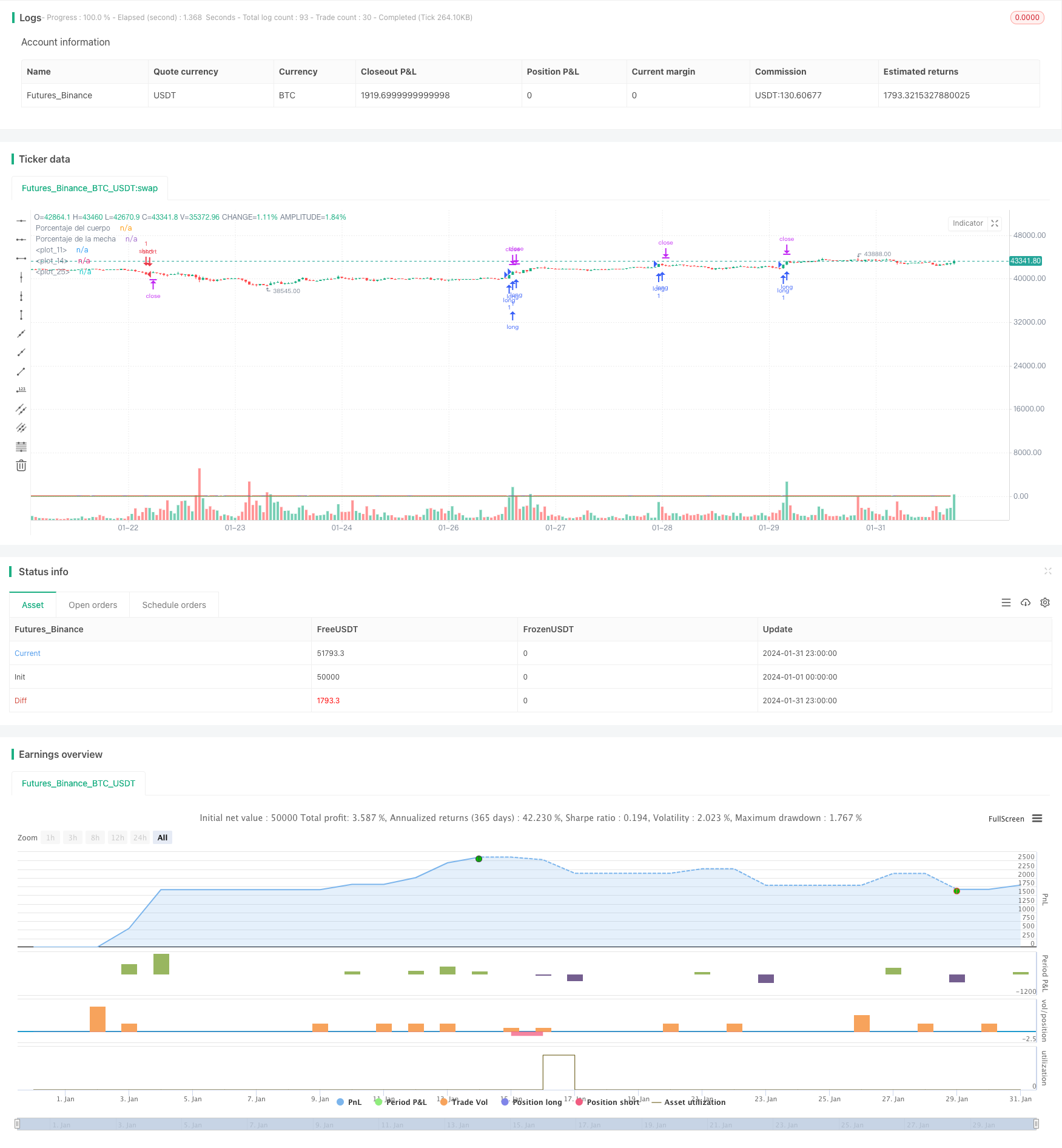Name
多时间周期动量反转策略Momentum-Reversal-Strategy-Based-on-Multiple-Timeframes
Author
ChaoZhang
Strategy Description
该策略基于价格的动量通过计算K线实体和影线比例,结合RSI指标判断市场超买超卖状态,寻找反转机会进行交易。主要用于短线交易,追踪中短线的价格势能反转点,以获得较高胜率。
该策略的核心逻辑基于以下几点:
-
计算K线的实体比例和影线比例:通过计算每根K线的open,close,high,low价格,得出实体和影线所占的百分比。当影线比例小于20%时,认为是强势的K线。
-
计算K线强度变化比例:计算每根K线内部价格变动幅度,判断K线的强弱。当变化幅度比较大时,表明动能较强,判断为强势K线。
-
结合RSI指标判断超买超卖:设置RSI的超买线和超卖线,RSI高于超买线时为超买,RSI低于超卖线时为超卖。超买超卖状态下的强势K线有较高概率发生反转。
-
判断反转信号:当影线比例小于20%且K线强度大于平均值的2倍时,且上一根K线的收盘价高于当前K线,表明满足反转的条件,做空;相反当收盘价低于当前K线则做多。
-
设置止损止盈:针对做多做空信号分别设置固定比例的止损位和止盈位。
该策略具有以下优势:
-
利用K线实体和影线的比例判断趋势和反转的能力较强。能有效判断价格的势能和反转点。
-
结合K线强度变化和RSI指标,判断反转信号的准确率较高。RSI的参数可调节,优化空间大。
-
止损止盈设置合理,有利于把握短线机会,降低单次交易的风险。
-
策略参数调整灵活,可针对不同品种、周期进行优化,实用性强。
该策略可能存在以下风险:
-
强势突破时,可能产生假信号,导致交易失败。可通过优化K线比较周期和RSI参数来减少。
-
反转失败的概率也存在,跟多在下跌行情和跟空在上涨行情都会被套。应适当调整止损位,减少损失。
-
效果与交易品种和时间周期相关。对于波动性不稳定的品种应谨慎使用该策略。
该策略可从以下几个方面进行优化:
-
优化K线比较的根数,寻找最佳判断超买超卖的周期参数组合。
-
优化RSI的超买超卖线,针对不同品种确定较好的参数。
-
测试不同的止损止盈比例设置,确定最佳止损止盈策略。
-
对交易品种按波动率分组优化,使策略参数针对性更强。
-
增加其他指标判断和过滤条件,提高策略稳定性。
本策略总体来说非常实用,通过对K线信息的应用判断价格势能反转点,是一种典型的短线交易策略。优化空间较大,可针对不同品种和交易环境进行调整,在跟踪中短线价格趋势方面效果较好。但需要注意防范止损和风险控制。
||
This strategy identifies trading opportunities by calculating candlestick body/wick ratios and combining RSI indicators to detect overbought/oversold market conditions. It aims to capture potential reversals in the price momentum over short-to-medium term timeframes.
The core logic of this strategy is based on the following:
-
Calculate body/wick percentage of candlesticks: By computing open, close, high and low prices, derive the percentage occupied by candle body and wicks. Wick percentage below 20% indicates a strong candle.
-
Compute candle strength change percentage: Calculate the internal price movement magnitude of each candle to determine candle strength. Larger fluctuations imply stronger momentum and hence indicate stronger candles.
-
Combine with RSI to identify overbought/oversold conditions: Set overbought and oversold threshold lines for RSI. RSI above overbought line signifies overbought state and vice versa for oversold. Strong candles in such states have high probability of reversal.
-
Determine reversal signals: When wick percentage < 20% and candle strength > 2 x average strength, along with previous candle close higher than current candle close, it signals short condition. The opposite indicates long condition.
-
Define stop loss and take profit: Set fixed percentage-based stop loss and take profit levels separately for long and short trades.
The advantages of this strategy include:
-
Effective identification of trend and reversals using candle body/wick proportions. Detects price momentum and turning points well.
-
Higher accuracy of reversal signals by combining candle strength change and RSI. RSI is adjustable providing greater optimization capability.
-
Reasonable stop loss/take profit configuration to capitalize on short-term opportunities while lowering trade risk exposure.
-
Flexible tunability of parameters for optimizing across different products and timeframes. High practical utility.
Some risks present in the strategy:
-
Potential false signals during strong trend breakouts. Can be reduced via optimization of candle comparison periods and RSI parameters.
-
Probability of failed reversals can't be eliminated fully. Being long in downtrend and vice versa induces losses. Stop losses should be adjusted accordingly to minimize damage.
-
Performance depends on product and timeframe. Caution warranted when applying to highly volatile products.
The strategy can be optimized in the following ways:
-
Fine tune periods considered in identifying overbought/oversold to determine optimal parameter combinations.
-
Optimize overbought/oversold RSI thresholds based on product specifics.
-
Test stop loss/take profit ratios for deriving ideal risk management plan.
-
Categorize products as per volatility for more targeted parameter tuning.
-
Additional filters based on other indicators may improve robustness.
The strategy is highly practical overall for detecting reversals by understanding candlestick information. As a typical short-term trading system, it has sizable optimization capability across products and environments for tracking medium-term trends. However adequate risk control through stop losses is imperative.
[/trans]
Strategy Arguments
| Argument | Default | Description |
|---|---|---|
| v_input_int_1 | 14 | Periodo RSI |
| v_input_int_2 | 75 | Sobre Compra |
| v_input_int_3 | 25 | Sobre Venta |
Source (PineScript)
/*backtest
start: 2024-01-01 00:00:00
end: 2024-01-31 23:59:59
period: 1h
basePeriod: 15m
exchanges: [{"eid":"Futures_Binance","currency":"BTC_USDT"}]
*/
//@version=5
strategy("mecha larga study",overlay = true, max_bars_back = 600)
//Porcentaje Mecha cuerpo
bodyPercent = math.abs(open - close) / (high - low) * 100
wickPercent = 100 - bodyPercent
plot(bodyPercent, "Porcentaje del cuerpo", color.rgb(163, 76, 175))
plot(wickPercent, "Porcentaje de la mecha", color.red)
VelaDeFuerza = math.abs(((high[0] - low[0])*100)/high)//PORCENTAJE DE VARIACION DE UNA VELA
plot(VelaDeFuerza, color = color.purple)
Promedio = ((VelaDeFuerza[0] + VelaDeFuerza[1] + VelaDeFuerza[2] + VelaDeFuerza[3] + VelaDeFuerza[4] + VelaDeFuerza[5] + VelaDeFuerza[6] + VelaDeFuerza[7] + VelaDeFuerza[8] + VelaDeFuerza[9] + VelaDeFuerza[10] + VelaDeFuerza[11] + VelaDeFuerza[12] + VelaDeFuerza[13] + VelaDeFuerza[14] ) / 15)
plot(Promedio, color = color.yellow)
// rsi
per_Rsi = input.int(14, "Periodo RSI",minval= 11, maxval=20) //inicializo el rsi en 14 periodos pero doy la posibilidad al usuario de cambiarlo
rsi_Sc = input.int(75,"Sobre Compra",minval=68,maxval=80) //ENTRADA DE SOBRE COMPRA DE RSI
rsi_Sv = input.int(25,"Sobre Venta",minval=20,maxval=33) //ENTRADA DE SOBRE VENTA DE RSI
rsi= ta.rsi(close,per_Rsi)//guardo el rsi con los paramentros anteriores en una variable
//logica
MayorPromedio = Promedio + 0.800
plot(MayorPromedio, color = color.green)
Venta = bodyPercent > 80 and VelaDeFuerza > Promedio * 2 and close < close[1]
Compra = bodyPercent > 80 and VelaDeFuerza > Promedio * 2 and close > close[1]
precioVenta = Venta? close : na
precioCompra = Compra? close : na
tp1 = 0.00
sl = 0.00
tp1 := 0.003
sl := 0.010
TP1short = precioVenta - (precioVenta * tp1)
Slshort = precioVenta + (precioVenta * sl)
TP1long = precioCompra + (precioCompra * tp1)
SLlong = precioCompra - (precioCompra * sl)
name1 = "tp1"
name2 = "tp2"
name3= "SL"
if ( precioVenta )
strategy.entry("short", strategy.short , comment = "Sell SL: " + str.tostring(Slshort, "0.000") + " TP1: " + str.tostring(TP1short,"0.000") )
strategy.exit("exit" , "short", stop = Slshort , limit = TP1short ,qty_percent = 100 )
if ( precioCompra )
strategy.entry("long", strategy.long , comment = "Buy SL: " + str.tostring(SLlong, "0.000") + " TP1: " + str.tostring(TP1long,"0.000") )
strategy.exit("exit" , "long", stop = SLlong , limit = TP1long ,qty_percent = 100 )
Detail
https://www.fmz.com/strategy/442927
Last Modified
2024-02-27 14:27:49
